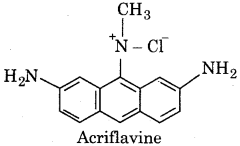Rajasthan Board RBSE Class 12 Chemistry Chapter 17 Chemistry in Daily Life
RBSE Class 12 Chemistry Chapter 17 Text Book Questions
RBSE Class 12 Chemistry Chapter 17 Very Short Answer Type Questions
Question 1.
What is saponification?
Answer:
Soaps are sodium or potassium salts of higher fatty acids (containing 15 – 18 carbon atoms) such as stearic acid and palmitic acid. The process of formation of soap is known as saponification. The process of saponification can be shown as
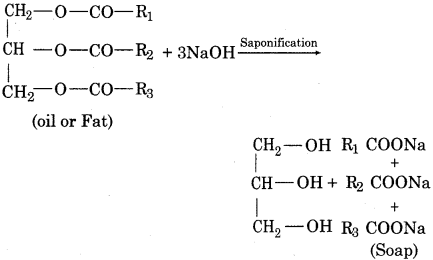
(Here R may be – C15H31,- C17H33 or – C17H35)
Question 2.
What are soft and hard soaps?
Answer:
Soft soaps: Soft soaps are potassium salts of fatty acids.
Hard soaps: Hard soaps are sodium salts of fatty acids.
Question 3.
What are detergents?
Answer:
The difficulty encountered with soaps with regard to cleaning with hard water is resolved by taking detergents. Detergents are chemicals that have all the properties of soaps but do not contain soap.
Example:

Question 4.
What are biodegradable and non-biodegradable detergents?
Answer:
Biodegradable detergents:
Detergents which can be decomposed by microorganisms present in water are called biodegradable detergents.lt is found that detergents that have straight chains of hydrocarbons in the molecules are biodegradable. For example, sodium lauryl sulphate.
Non-biodegradable detergents:
Detergents that are not degraded (decomposed) by the micro-organisms are called non-biodegradable detergents. An example of such a detergent is sodium 4 – (1, 3, 5, 7 tetramethyl octyl) benzenesulfonate. Such detergent causes environment pollution.

Question 5.
Give an example of cationic detergent.
Answer:
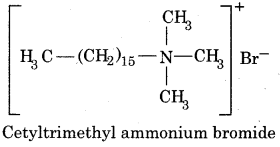
Question 6.
What are chromophores? Give an example.
Answer:
Chromophores are organic structures which give rise to colour.
Example:

Question 7.
What are auxochromes? Give an example.
Answer:
It is a group which itself does not act as chromophore but when attached to the chromophore, it shifts the adsorption towards longer wavelength along with an increase in the intensity of adsorption.
Examples:
– OH, – NH2 , – NHR, – NR2 are auxochromes.
Question 8.
What are mordant dyes? Give an Example.
Answer:
These are applied with the help of binding material (e.g. metal hydroxide) called mordant depending upon the metal ion used, the same dye can give different colours. Alizarin is an important example of such a dye.
Example:
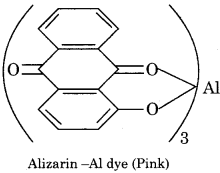
Question 9.
What are triphenylmethane dyes? Give an example.
Answer:
These dyes are amino derivatives of triphenyl methane. For example, malachite green is an important dye of this group. It is used to colour wool and silk directly.
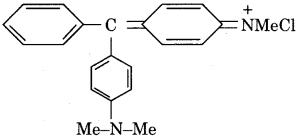
Question 10.
What are vat dyes? Give examples.
Answer:
These dyes are known from ancient times. Vat dyes are insoluble in water cannot dye fibres directly.
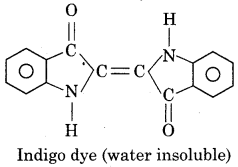
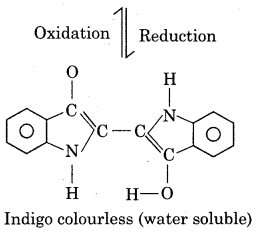
RBSE Class 12 Chemistry Chapter 17 Short Answer Type Questions
Question 1.
What are soaps? Give an example?
Answer:
The sodium and potassium salts of higher fatty acids such as stearic acid, oleic acid are called soaps.
Example:
Sodium palmitate (C15H31COONa).
Question 2.
Write the differences between soaps and detergents?
Answer:
Differences between soaps and detergents:
| Soaps | Detergents |
| Soaps are sodium salts of long chain fatty acids. | Detergents are sodium salts of long chain alkyl sulphonates or long chain alkyl benzene sulphonates. |
| They cannot be used in acidic solutions. | They can be used even in acidic solutions. |
| They cannot be used in hard water as they produce precipitates with Ca+ and Mg2+ ions. | They can be used even in hard water as they do not form any precipitates with Ca2+ or Mg2+ ions. |
Question 3.
Explain the cleansing action of soaps and detergents with the help of micelle formation.
Answer:
Soaps and detergents consist of a large hydrocarbon tail with negatively charged head. The hydrocarbon tail is hydrophobic (water repelling) and the negatively charged head is hydrophilic (water-attracting).
The dirt in the cloth is due to the presence of dust particles in fat or grease which stick to the cloth. When soap or detergent is dissolved in water the molecules gather together as clusters called micelles when the dirty cloth is dipped in soap or detergent solution. The soap and dirt particles come in contact with each other.
The non-polar tails of the soap begin to dissolve in non – polar oil or grease. While the polar head part remains in the water. As more and more soap particles enter the grease each fat or oil particle is surrounded by a number of negatively charged ends. Since the similar charges repel each other the oil or grease droplets break off into small globules of oil. These are still surrounded by the negatively charged polar heads of the soap molecules.
This prevents the small globules from coming together to form bigger particles. The rubbing by hands or mechanical stirring also helps to break the grease particles. In this manner, the grease particles can be completely broken up and it forms an emulsion of grease or oil contained in dirt and the droplets are washed away with water.
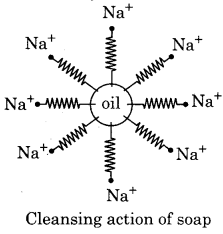
Question 4.
What are soapless soaps? Explain with example.
Answer:
Synthetic detergents have all the soap’s properties but actually does not contain any soap. So they are known as “soapless soaps”. They are also known as detergents. Detergents can be used in both soft and hard water.
Example:

Question 5.
Explain cationic, anionic and non-ionic detergents with example.
Answer:
Cationic detergents:
Cationic detergents are those which have a cationic hydrophilic group. These are mostly acetates, bromides, chlorides of quaternary ammonium salts.
Example:

Anionic detergents:
Anionic detergents are those which have an anionic hydrophilic group. These are manufactured from long chain alcohols.
Example:
Sodium lauryl sulphate [C11H23CH2OSO3Na] sodium p – dodecyl benzene sulphonate

Natural detergents:
These detergents are simply long chain organic compounds and are esters in nature. These contain polar groups which can form hydrogen bonds with water.
Example: Polyethylene glycol stearate
[CH3 (CH2)16 COO(CH2CH2O)n CH2CH2OH]
Question 6.
Which type of dye is phenolphthalein? Write its structure.
Answer:
The compounds formed by a combination of phthalic anhydride and phenolic compounds are known as phthalein. For example, phenolphthalein has phthalein as a ring structure.
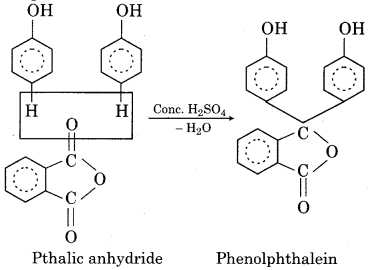
Question 7.
Give the structure of the following dyes:
1. Methyl orange
2. Fluorescence
3. Alizarin
Answer:
1. Methyl orange

2. Fluorescence
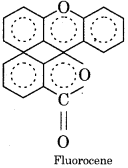
3. Alizarin
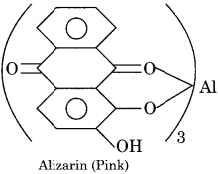
Question 8.
Write the differences between dyes and pigments.
Answer:
Differences between dyes and pigments:
| Dyes | Pigments |
| They are soluble in water. | Pigments are colourants that are insoluble in water and most of the solvents. |
| Lower dyes are very much vulnerable. Light destroy coloured objects by breaking open electronic bonding within the molecule. | Traditionally pigments have been found to be more lightfast than dyes. |
| Usually, the dye is organic compounds. | Pigments are normally inorganic compounds. |
Question 9.
Write the general characteristics of dyes.
Answer:
A dye has the following characteristics:
- It must have a suitable colour.
- It can be fixed on the fabric either directly or with the help of mordant.
- It must be resistant to the action of water, acid and alkalies. The groups responsible for colour are called chromophores.
- These should be unaffected by light.
Question 10.
Write short notes on
(a) Direct Dyes
(b) Disperse Dyes
(c) Ingrain dyes
Answer:
(a) Direct Dyes:
The fibres are soaked in a hot solution of dye then dries after taking out. These dyes applied directly to fibre and more useful to the fabrics containing H – bonding like cotton, rayon, wool, silk nylon,
Example: Martius yellow, congo red, etc.
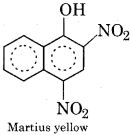

(b) Disperse Dyes:
Disperse dyes are water-insoluble. These dyes are finely grinding and are available as a paste or a powder that gets dispersed in water.
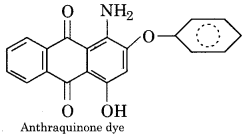
(c) Ingrain dyes:
These dyes are also known as ‘ice-colours’ because they react at low temperatures. Ingrain dyes are that which are synthesized directly on the fabric.
For Example Azo dyes.
RBSE Class 12 Chemistry Chapter 17 Long Answer Type Questions
Question 1.
What are soaps? How are they prepared? Explain its cleansing actions.
Answer:
Soaps are sodium or potassium salts of higher fatty acids (containing 15 – 18 carbon atoms) such as stearic acid and palmitic acid. The process of formation of soap is known as saponification. The process of saponification can be shown as

(Here R may be – C15H31,- C17H33 or – C17H35)
Soaps and detergents consist of a large hydrocarbon tail with negatively charged head. The hydrocarbon tail is hydrophobic (water repelling) and the negatively charged head is hydrophilic (water-attracting).
The dirt in the cloth is due to the presence of dust particles in fat or grease which stick to the cloth. When soap or detergent is dissolved in water the molecules gather together as clusters called micelles when the dirty cloth is dipped in soap or detergent solution. The soap and dirt particles come in contact with each other.
The non-polar tails of the soap begin to dissolve in non – polar oil or grease. While the polar head part remains in the water. As more and more soap particles enter the grease each fat or oil particle is surrounded by a number of negatively charged ends. Since the similar charges repel each other the oil or grease droplets break off into small globules of oil. These are still surrounded by the negatively charged polar heads of the soap molecules.
This prevents the small globules from coming together to form bigger particles. The rubbing by hands or mechanical stirring also helps to break the grease particles. In this manner, the grease particles can be completely broken up and it forms an emulsion of grease or oil contained in dirt and the droplets are washed away with water.

Question 2.
What are detergents? Give its classification and its cleansing action.
Answer:
The difficulty encountered with soaps with regard to cleaning with hard water is resolved by taking detergents. Detergents are chemicals that have all the properties of soaps but do not contain soap.
Detergents are mainly classified into three categories:
1. Anionic detergents
2. Cationic detergents
3. Non-ionic detergents
Cleaning Action:
Soaps and detergents consist of a large hydrocarbon tail with negatively charged head. The hydrocarbon tail is hydrophobic (water repelling) and the negatively charged head is hydrophilic (water-attracting).
The dirt in the cloth is due to the presence of dust particles in fat or grease which stick to the cloth. When soap or detergent is dissolved in water the molecules gather together as clusters called micelles when the dirty cloth is dipped in soap or detergent solution. The soap and dirt particles come in contact with each other.
The non-polar tails of the soap begin to dissolve in non – polar oil or grease. While the polar head part remains in the water. As more and more soap particles enter the grease each fat or oil particle is surrounded by a number of negatively charged ends. Since the similar charges repel each other the oil or grease droplets break off into small globules of oil. These are still surrounded by the negatively charged polar heads of the soap molecules.
This prevents the small globules from coming together to form bigger particles. The rubbing by hands or mechanical stirring also helps to break the grease particles. In this manner, the grease particles can be completely broken up and it forms an emulsion of grease or oil contained in dirt and the droplets are washed away with water.

Question 3.
Explain Witt theory for structural properties of dyes.
Answer:
In 1876, a German scientist Otto Witt put forward a theory known as “Chromophore Auxochrome theory” or Witt theory. Some important points of this theory are:
(i) The colour of a substance is mainly due to the presence of unsaturated groups known as chromophores. The important chromophores are:
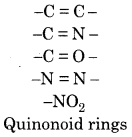
(ii) The compounds possessing chromophores are referred to as chromogens. The higher the number of chromophores in a chromogen higher is the colour bearing capacity. The chromospheric groups are of the following two types:
1. When a single chromophore is sufficient to impart colour to the compound.
Example: NO, NO2, N = N, = N = N,N = NO, p – quinonoid etc.
2. When more than one chromophores are required to impart the colour.
Example: > C = O, > C < etc.
3. Certain groups, which do not produce colour themselves when present along with a chromophore in an organic substance, intensify the colour. Such colour assisting groups are called auxochromes. They make the colour deep and fast.
Question 4.
Classify dyes on the basis of applications.
Answer:
Classification of dyes on the basis of applications:
(i) Direct Dyes:
The fibres are soaked in a hot solution of dye and then dries after taking out. These dyes applied directly to fibre and are more useful to the fabrics containing H-bonding like cotton, rayon, wool, silk and nylon.
Examples:
Martius yellow, Congo red etc.
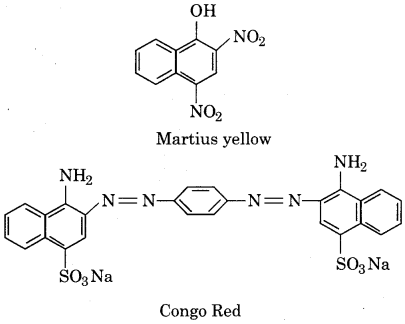
(ii) Acidic Dyes:
These dyes are used in slightly acidic medium and are generally sulphonic acid and its derivatives. These are water soluble. These do not have an affinity for cotton but are used for silk, wood etc.

(iii) Basic Dyes:
These dyes contain basic group (like – NH2 group) and react with anionic sites present on the fabric. These are used to dye nylons and polyester.
Example:
Aniline yellow.

(iv) Disperse Dyes:
Disperse dyes are water-insoluble. Their dyes are finely grinding and are available as a paste or a powder that gets dispersed in water. These particles are dissolved in the fibres and impart colour to them. These dyes were originally developed for the dyeing of cellulose acetate but now they are used to dye nylon, cellulose triacetate and acrylic fibres too.
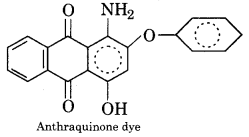
(v) Reactive Dyes:
Reactive dyes react with fibres molecules to form a chemical compound. Reactive dyes were originally used for cellulose fibres only but now their various types are used for wool, silk, nylon, acrylics and their blends as well.
Example:
Prussian red.
(vi) Ingrain Dyes:
These dyes are also known as ‘ice-colours’ because they react at low temperatures. Ingrain dyes are those which are synthesized directly on the fabric.
Example:
Azo-dye.
Question 5.
Classify dyes on the basis of structure.
Answer:
On the basis or structure, dyes can be classified as:
(i) Nitro and Nitroso Dyes:
These are ancient known dyes. These dyes contain nitro or nitroso groups as the chromophores and -OH as Auxo chrome. A few Examples:
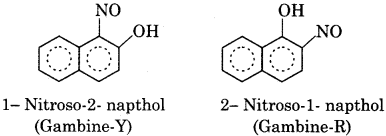
(ii) Diphenyl Methane Dyes:
These dyes have a basic structure of diphenylmethane.
Example:
Auramine – O is an important dye of this group which used to colour silk, wool, paper, jute etc.
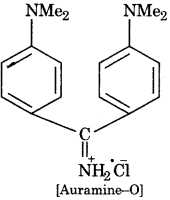
(iii) Triphenyl Methane Dye:
These dyes are amino derivatives of triphenyl methane.
Example:
Malachite green which is used to colour woof and silk directly.
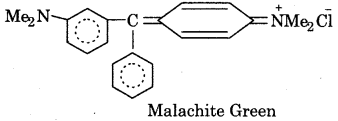
(iv) Phthalein Dyes:
The compounds formed by the combination of phthalic anhydride and phenolic compounds are known as phthalein. Xanthene ring structure can also be included in this group.
Example:
Phenolphthalein has phthalein as a ring structure and fluorescein is a xanthene derivative.
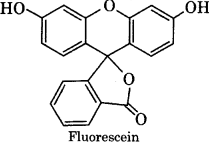
(v) Azo – Dyes:
It is the largest group of synthesized dyes which contain almost all the colours. Dyes characterised by the presence of an azo group (- N = N -) as the chromophore.
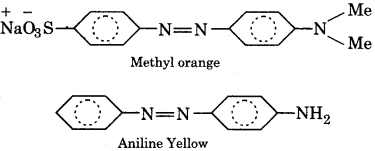
(vi) Indigo Dyes:
This is the most important group of natural dyes. The dyestuff is extracted from Indigofera tinctoria, a bush pea family.
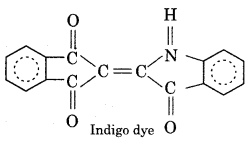
(vii) Anthraquinone Dyes:
Dyes that have anthraquinone as their base and the carbonyl group (> C = O) as the chromophore. These dyes can be used with mordant dye where it gives different colours with different ions.
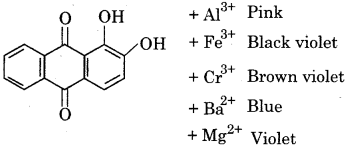
(viii) Heterocyclic dyes:
In these dyes at least one odd cyclic ring should be present. It is also a large group and new dyes are discovered.
